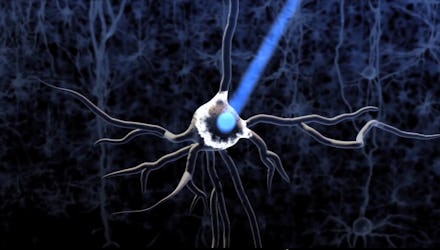In a Breakthrough, Scientists Have Discovered a Way to Turn Off Nerves That Cause Pain

The breakthrough: A team of biotech researchers at Stanford have created mice whose sensitivity to pain can be controlled by shining light onto their paws. Scientists hope to use these advances to develop an inexpensive light-based treatment for people with debilitating chronic pain. "This is an entirely new approach to study a huge public health issue," said lead investigator professor Scott Delph. "It's a completely new tool that is now available to neuroscientists everywhere.”
How did they do it? In a paper published in Nature Biotechnology this week, scientists described that they achieved this amazing feat by altering the DNA in test mice using a technique known as optogenetics. This high-tech method involves injecting mice with an engineered virus containing genes that make light-sensitive proteins, called opsins. When opsins absorb light they change in shape, which triggers the nerve cell to behave differently. Previously this technique has been used to control muscle behaviour in mice.
Image: Optogenetics (Credit: Circuittx)
When doing these previous experiments, scientists would occasionally find that the engineered virus would unintentionally reach nerve cells that controlled pain. This happy accident led the Stanford team to focus on this new line of research. In the new experiments, the scientists first introduced an opsin that reacted to blue light, creating pores in the nerve cells. They then saw that shining blue light on the mouse’s paw made the animal flich and try to avoid the light.
(Adapted from Nature Biotechnology)
When the group made two connected chambers, one with red light, one with blue, they found that 80% of the injected mice avoided the blue areas.
(Adapted from Nature Biotechnology)
The scientists then injected the mice with a different type of opsin — one that reacts to yellow light, and instead prevents the nerve cells from firing in response to pain. This time, conducting pain tests such as applying an infrared beam of heat to the mouse’s paw, they found that injected mice which were exposed to yellow light took significantly longer to flinch.
(Adapted from Nature Biotechnology)
As a control, the researchers shone blue light onto mice injected with the same engineered virus, but this time with the opsin DNA missing. Mice did not flinch in this instance.
(Adapted from Nature Biotechnology)
What this means for humans: This research opens the door to future experiments that can help us understand the nature of pain better. For instance, when pain continues after an injury has healed, is it because the nerves have changed in some way? And if so, can the pain signals be turned off somehow now that the injury has gone?
While other therapies may quickly be developed with this knowledge, using light itself for human pain therapy may be more than a decade off. First, scientists need to learn more about the specifics of where to shine the light to get an effective response and how much of it is needed. Also, the process involves gene delivery, which itself is still a technique that requires more research to be perfected.
Still, these results are considered a resounding success for two reasons: (1) showing that it is possible to create a switch to turn on and off the nerves causing pain at will, and (2) being able to do this by shining light from the outside of an organism and still have the effect take hold. Leaders in medicine are growing excited about its future applications. "This powerful approach shows great potential for helping the millions who suffer pain from nerve damage," said Linda Porter, the pain policy adviser at the National Institutes of Health.
Video: An example explaining optogenetics (Credit: MIT)
Around $635 billion each year is being spent on health in the U.S., with pain being the main reason patients seek out doctors. Right now the medicine that is available for controlling pain has unfortunate side effects such as leaving users with muddled minds, or creating long-term addictions. These results envision an exciting future alternative: a light-based treatment that is much more easy to administer, is flexible and can target different types of pain, and is much more precise.